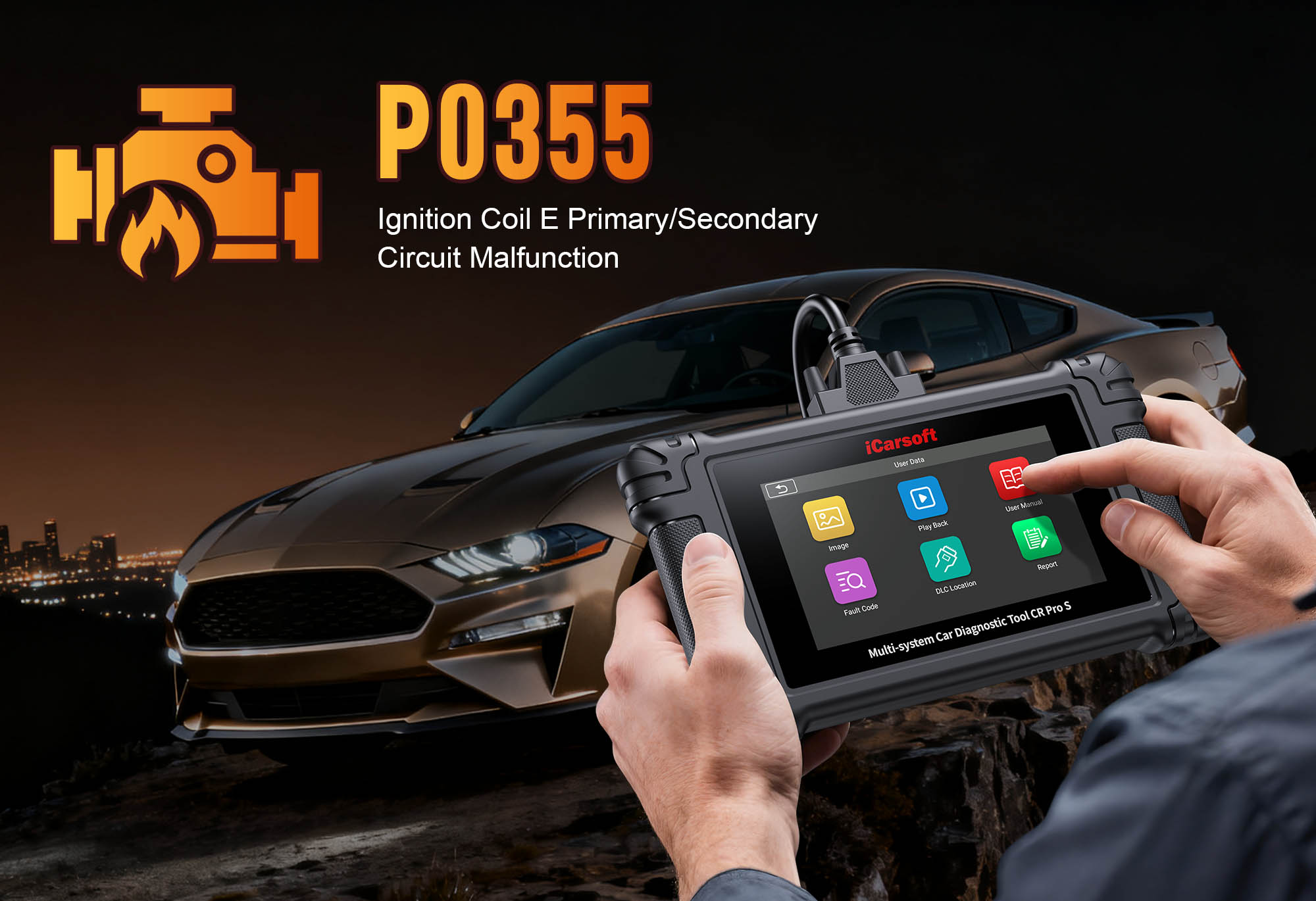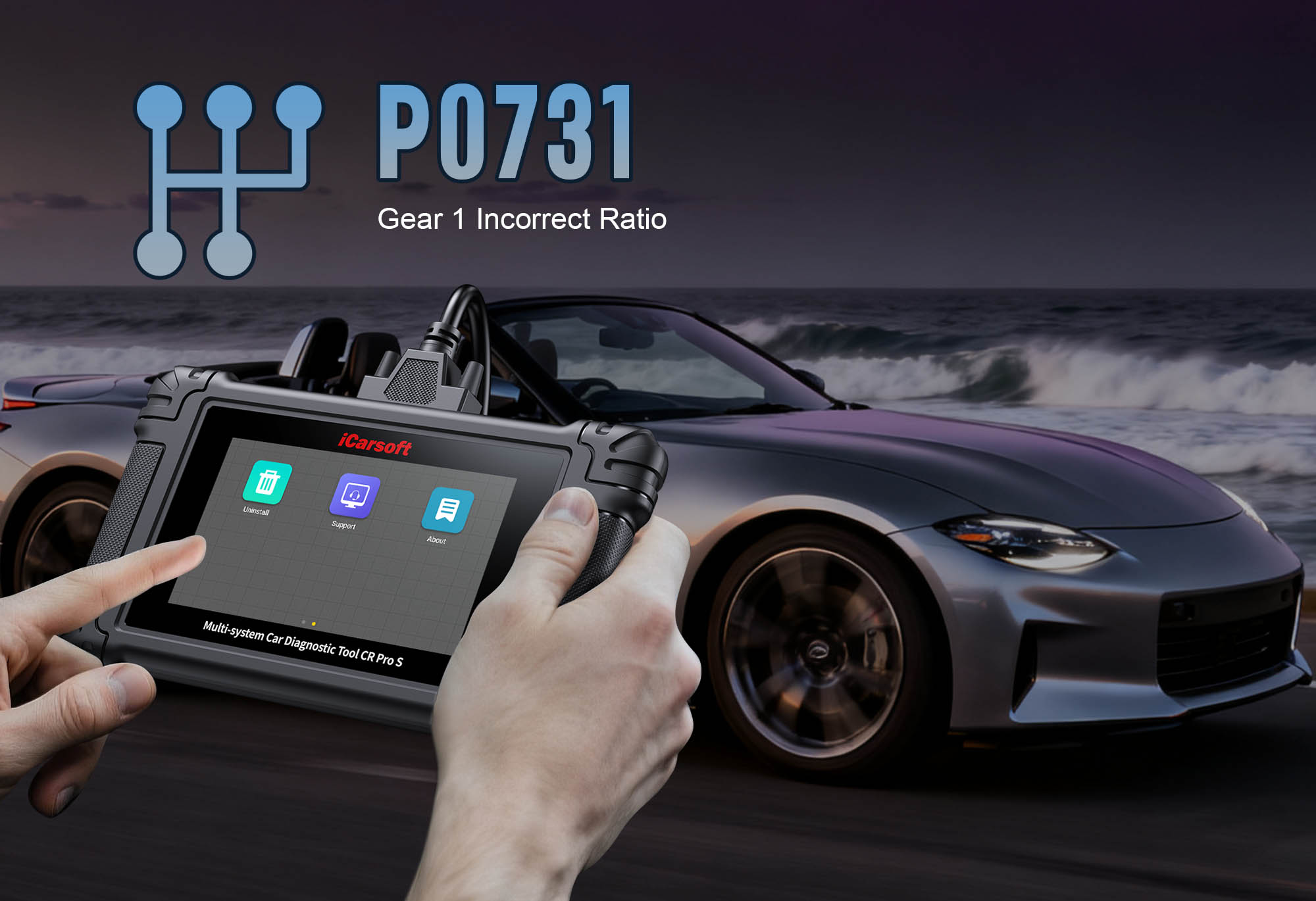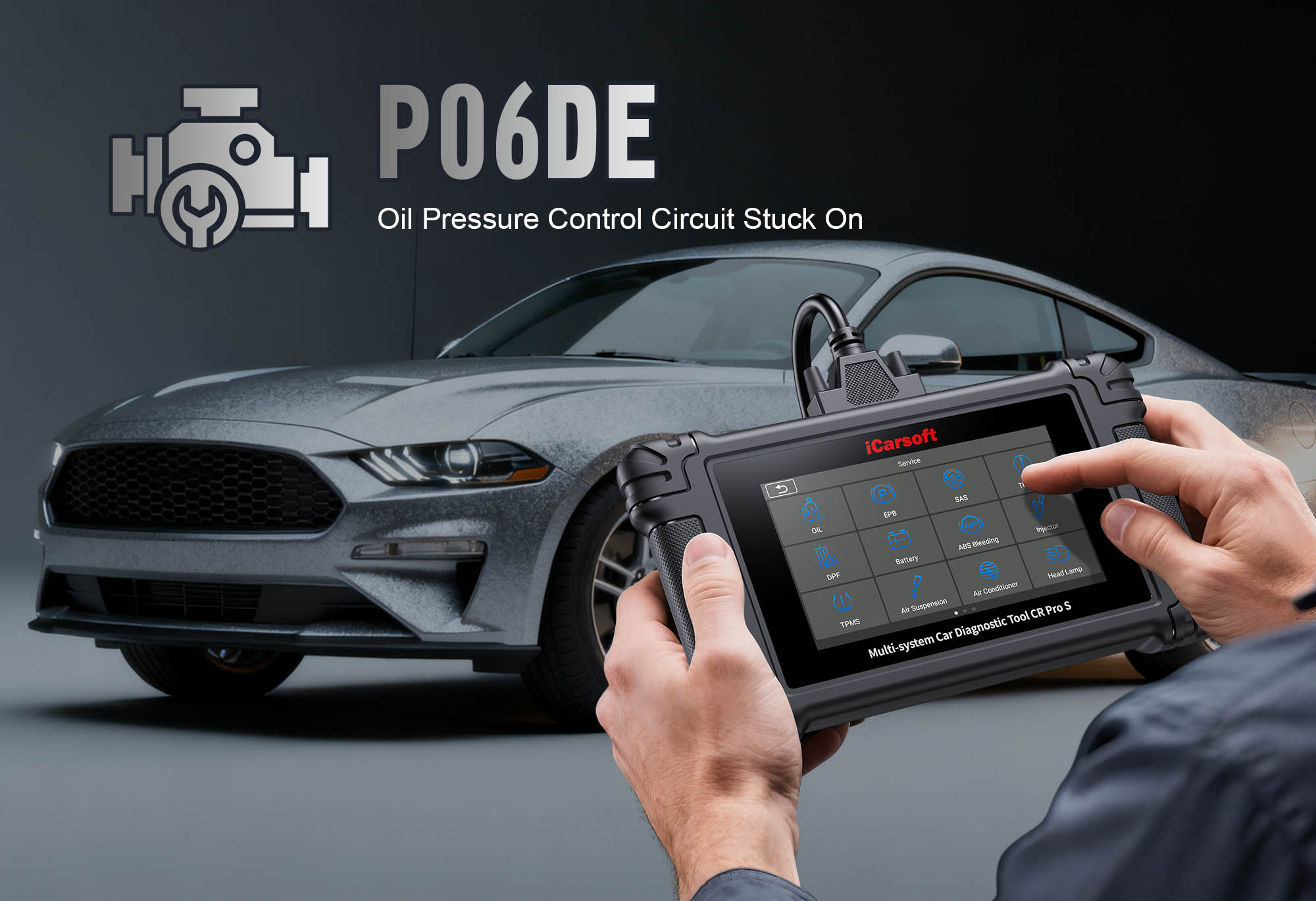Diagnose & Clear P0355 with iCarsoft CR Pro S: Fix Ignition Coil "E" Primary/Secondary Circuit Malfunction
If your check engine light flashes and you experience symptoms like rough idling, engine misfires, or reduced power, a diagnostic scan will likely return P0355. This OBD-II code stands for "Ignition Coil 'E' Primary/Secondary Circuit Malfunction," indicating the Engine Control Module (ECM) has detected a fault in the electrical circuit of the ignition coil assigned to cylinder "E"—typically cylinder 5 in 6+ cylinder engines, though numbering varies by manufacturer.
Ignition coils convert the vehicle’s 12V battery power into the high voltage (20,000–50,000V) needed to ignite the air-fuel mixture in the combustion chamber. Each coil (or coil pack) is controlled by the ECM, which sends a signal to trigger the coil at the precise moment for optimal combustion. A "circuit malfunction" (P0355) means the ECM is not receiving the expected feedback from coil "E"—this could be due to a short, open circuit, or failed coil, disrupting spark production in its assigned cylinder. Left unaddressed, P0355 can cause catalytic converter damage, increased fuel consumption, and even engine overheating from unburned fuel.
Basic scanners may only flag "ignition coil fault" but can’t isolate the specific circuit issue or test coil functionality. The iCarsoft CR Pro S, with its ignition coil diagnostics, live circuit monitoring, and bi-directional tests, solves this. Let’s walk through how to diagnose and resolve P0355 with precision.
Understanding P0355: Causes & Key Symptoms
A faulty ignition coil "E" circuit disrupts spark in its cylinder, with symptoms that align with incomplete combustion—these clues help separate coil/circuit issues from other engine faults.
Key Symptoms of P0355
-
Engine Misfires: A distinct "sputtering" or shaking, especially under load (e.g., accelerating, climbing hills)—most noticeable in cylinder "E" (use the CR Pro S to identify the exact cylinder for your vehicle).
-
Rough Idling: The engine vibrates heavily at idle (500–1,000 RPM) as unburned fuel in cylinder "E" throws off engine balance.
-
Reduced Power & Acceleration: The engine feels sluggish, struggling to reach higher speeds due to one non-functional cylinder.
-
Increased Fuel Consumption: The ECM enriches the fuel mixture to compensate for misfires, raising fuel usage by 15–25%.
-
Flashing Check Engine Light: A critical indicator—signals misfires are severe enough to damage the catalytic converter.
-
Catalytic Converter Overheating: Unburned fuel enters the converter, causing it to glow red-hot (risk of fire or permanent damage).
Common Causes of P0355
|
Cause
|
Description
|
|
Failed Ignition Coil "E"
|
Internal shorting or burnout of the coil’s windings (common in coils >80,000 miles) disrupts voltage conversion.
|
|
Wiring/Connector Issues
|
Frayed wires, corroded terminals, or loose plugs in the coil’s power/signal circuit break electrical flow.
|
|
Faulty ECM Driver
|
The ECM’s internal component that triggers the coil fails, preventing it from sending activation signals.
|
|
Damaged Spark Plug/Wire
|
A worn spark plug (gap >0.045") or cracked wire creates excessive resistance, overloading the coil.
|
|
Ground Circuit Failure
|
A loose or corroded ground strap for the ignition system increases circuit resistance, causing coil malfunctions.
|
|
Water Intrusion
|
Moisture in the coil connector (from leaks or high humidity) causes short circuits, especially in engines with top-mounted coils.
|
Why iCarsoft CR Pro S Excels at Diagnosing P0355
The CR Pro S outperforms basic tools with features tailored to ignition coil circuit diagnostics—critical for resolving P0355 without guesswork:
Cylinder Identification
Precisely identifies which cylinder corresponds to "E" (e.g., cylinder 5 in V8 engines like Ford 5.0L or Chevrolet 6.2L).
Live Coil Circuit Monitoring
Tracks real-time voltage, current, and resistance in the ignition coil "E" circuit to spot shorts or opens.
Bi-Directional Coil Tests
Manually activates ignition coil "E" to check for spark, verifying if the coil or circuit is faulty.
Spark Plug Health Checks
Integrates with cylinder compression data to rule out worn plugs as the root cause of P0355.
Global Vehicle Coverage
Works with 500+ models (gasoline/hybrid) from Ford, Toyota, BMW, Mercedes-Benz, Dodge—adapting to all coil types.
ECM Driver Verification
Tests if the ECM sends proper trigger signals to the coil, ruling out module faults.
Step-by-Step: Diagnose P0355 with iCarsoft CR Pro S
-
1. Identify Cylinder "E" & Locate Ignition Coil "E"
First, confirm the affected cylinder and coil for targeted testing:
1. Navigate to Component Location > Engine > Ignition System > Ignition Coils on the CR Pro S.
2. Use the tool’s diagram to note:
- Cylinder Numbering: "E" = cylinder 5 in 6-cylinder (e.g., BMW N55) or 8-cylinder (e.g., Ford Coyote 5.0L) engines.
- Coil "E" Position: e.g., rear bank (V8) or front bank, second from left (inline-6).
- Wiring: Power (12V), ground, and ECM signal wires connected to the coil.
-
2. Connect the CR Pro S & Confirm the Code
1. Plug the tool into the vehicle’s OBD-II port (use OBDI adaptors for older models: Mercedes 38Pin, BMW 20Pin).
2. Power on and select your vehicle via Auto VIN Identify (instant specs) or manual entry.
3. Navigate to Engine > Fault Codes > Read Codes to confirm P0355. Tap Code Details for vehicle-specific tips (e.g., "Dodge Ram 1500 (5.7L V8): Check coil resistance 0.5–1.5 Ohms Primary").
-
3. Perform a Visual Inspection of Coil "E" & Circuit
Start with simple checks to spot obvious issues:
1. Coil Inspection: Remove coil "E" (use the CR Pro S’s Torque Guide for bolt specs). Check for cracks, oil leaks (from valve cover gaskets), burn marks, or loose connections.
2. Spark Plug Check: Remove the plug from cylinder "E" (use a spark plug socket). Inspect for excessive wear (gap >0.045"), fouling (black soot = rich mixture), or oil (signals gasket leak).
3. Wiring/Connector Check: Examine the coil’s connector for corrosion (clean with electrical contact cleaner); check wires for fraying or heat damage (near exhaust).
-
4. Analyze Live Ignition Coil "E" Data
Real-time data reveals circuit functionality:
1. Start the engine (if possible) and idle for 5 minutes.
2. Navigate to Engine > Live Data > Ignition System > Ignition Coil "E" and monitor:
- Primary Circuit Voltage: Normal = 11–14V. <10V = power issue; 0V = open circuit.
- Primary Circuit Resistance: Normal = 0.5–1.5 ohms. >2 ohms = faulty coil; 0 ohms = short.
- ECM Trigger Signal: Should pulse 5–12V. No pulse = ECM driver fault or broken signal wire.
- Cylinder "E" Misfire Count: Increases with each misfire (confirms no spark).
-
5. Test Ignition Coil "E" Resistance
Verify coil health via resistance checks:
1. Turn off the engine and disconnect the coil’s electrical connector.
2. Use the CR Pro S’s Multimeter Function to test:
- Primary Windings: Measure between power and signal pins. Normal = 0.5–1.5 ohms.
- Secondary Windings: Measure between primary pin and spark plug terminal (coil-on-plug). Normal = 8,000–15,000 ohms.
3. Compare to manufacturer specs (in the tool’s Specs tab): Out-of-range = faulty coil (replace).
-
6. Swap Coils to Confirm Fault (Quick Test)
Isolate coil vs. circuit issues:
1. Swap coil "E" with a known good coil (e.g., coil "A"—use the tool’s diagram for safe swaps).
2. Clear codes via the CR Pro S, then test drive 10–15 minutes.
3. Rescan:
- If P0355 moves to the swapped cylinder (e.g., P0351), original coil "E" is faulty.
- If P0355 remains, issue is in cylinder "E"’s circuit (wiring/ECM).
-
7. Test the Coil Circuit for Shorts & Continuity
If the coil tests good, check wiring and signals:
1. Power Supply Test: Disconnect the coil connector. Set multimeter to "DC Voltage"—touch power pin and ground. Ignition "ON" (no start) = 12V. 0V = blown fuse/broken wire (check via Fuse Guide).
2. Signal Wire Continuity: Measure resistance between coil signal pin and ECM pin (use wiring diagram). Normal = <5 ohms. Higher = corrosion/fraying.
3. Short-to-Ground Test: Measure resistance between signal wire and ground. Normal = >10,000 ohms. <100 ohms = short (repair wire).
-
8. Perform a Bi-Directional Coil Activation Test
Verify ECM trigger functionality:
1. Navigate to Special Functions > Engine > Ignition System > Coil Activation Test.
2. Select "Coil 'E'" and follow prompts (engine off, key on).
3. Check for:
- A clicking sound (coil firing).
- Spark via a spark tester connected to the coil.
4. No spark = faulty coil, ECM driver, or signal wire.
-
9. Repair & Clear P0355
Fix the root cause based on diagnostics:
1. Address specific issues:
- Faulty Coil "E": Replace with OEM/quality aftermarket coil (use Part Lookup for compatibility).
- Wiring/Connector: Repair frayed wires or clean corroded terminals.
- Bad Spark Plug: Replace with manufacturer-recommended plug (correct heat range/gap).
- ECM Driver Fault: Update firmware via Update Manager or consult a professional.
- Oil Leak: Replace valve cover gasket to protect the new coil.
2. Clear the code: Navigate to Engine > Fault Codes > Clear Codes to delete P0355.
-
10. Validate the Repair
Confirm P0355 is resolved:
1. Recheck live data: Coil voltage/resistance is within specs; ECM trigger signal pulses normally.
2. Test drive 20–30 minutes (idle, acceleration, highway)—no misfires or rough idling.
3. Post-drive scan: Use Ignition System Scan after 50 miles to confirm P0355 doesn’t return.
4. Check exhaust temp: Use Exhaust Temperature data—should stay <1,200°F (no converter overheating).
Preventing P0355 Recurrence
Use the iCarsoft CR Pro S to maintain ignition coil health and avoid future P0355 codes:
-
Coil Maintenance: Set the Service Reminder to inspect ignition coils every 60,000 miles; replace all coils at 100,000–120,000 miles to avoid sequential failures.
-
Spark Plug Replacement: Change spark plugs every 30,000–60,000 miles (per manufacturer specs) to prevent excessive coil strain.
-
Wiring Checks: Include ignition coil circuit continuity tests in annual electrical scans—catch corrosion or wear early.
-
Oil Leak Prevention: Inspect valve cover gaskets every 50,000 miles; replace them at the first sign of leaks to protect coils.
Conclusion
P0355’s ignition coil "E" circuit malfunction causes misfires and risks catalytic converter damage—but the iCarsoft CR Pro S simplifies diagnosis with coil testing, circuit checks, and live data monitoring. Whether replacing a faulty coil, fixing wiring, or updating the ECM, this tool ensures you fix the root cause (not just the symptom).
With the CR Pro S, you’ll restore reliable spark in cylinder "E," eliminate misfires, and keep your engine running smoothly—no more costly converter repairs or guesswork.
FAQs About P0355 Code
Q: Can I drive with P0355?
A: Only short distances (to a repair shop). Prolonged driving risks catalytic converter damage or engine overheating from unburned fuel. Stop driving immediately if the check engine light flashes.
Q: How much does it cost to fix P0355?
A: $50–$200 for an ignition coil; $30–$100 for a spark plug; $80–$300 for wiring/connector repairs; $150–$500 for ECM firmware updates or driver repairs. The CR Pro S saves by avoiding unnecessary part replacements.
Q: Will replacing ignition coil "E" always fix P0355?
A: No—if P0355 stems from wiring issues, a faulty ECM driver, or a bad spark plug, replacing the coil won’t resolve it. Use the CR Pro S to test the circuit first.
Q: What’s the difference between P0355 and P0305?
A: P0355 = "Ignition Coil 'E' Circuit Malfunction" (electrical fault in the coil/circuit); P0305 = "Cylinder 5 Misfire Detected" (general misfire, could be from fuel, air, or spark issues). The CR Pro S distinguishes them via coil circuit tests vs. misfire data.





